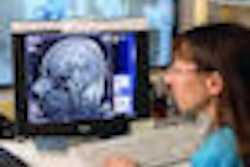A few well-chosen words of encouragement can go a long way in relaxing a nervous patient about to undergo an MRI scan. Taken one step further, new research also suggests that patient self-hypnosis can reduce the number of cancelled and rescheduled exams.
A study from Harvard University in Boston has found that teaching advanced communication skills and self-hypnotic relaxation techniques to MRI staff members can help them deal more effectively with patients and significantly increase the number of successful scans, even among patients with claustrophobia.
The study, published online in September by Academic Radiology, was led by Dr. Elvira Lang, associate professor of radiology at Harvard and founder of Hypnalgesics, a Brookline, MA-based company that trains medical and nonmedical personnel in advanced communication and rapid hypnotic techniques to improve patient outcomes.
According to a 2007 study published in the Journal of Magnetic Resonance Imaging, an average of 2.3% of patients cannot complete an MRI scan for a variety reasons, including claustrophobia, the noise from the MRI system, or because they are uncomfortable or in pain.
Reimbursement consequences
As noted in the Harvard study, the result of uncompleted MRI scans is disrupted patient care and it's an impediment to an MRI facility's workflow and revenue stream.
The foundation of the research was set about 15 years ago, when Lang began a research program in procedure hypnosis to develop techniques to help patients through imaging exams. Since then, she and her colleagues have conducted randomized, prospective studies of more than 700 patients "to show that the personnel can very easily help patients and make procedures more comfortable, safer, and faster," she added.
The researchers then began to put their theory into practice in February and March 2007 at an imaging practice operated as a joint venture between two community hospitals, which partnered to provide MRI exams for area patients. The three-site practice included six MRI systems, with two mobile units for inpatients and an open MRI magnet for patients with claustrophobia or anxiety about possible claustrophobia.
Although the practice had experienced lower-than-average problem patients with claustrophobia, cancelled or postponed appointments had an adverse effect on reimbursement revenue.
Staff training
Training of the practice's staff included an advanced rapport session and a self-hypnotic relaxation component. One physician and two psychologists provided a total of 17 classroom hours in addition to an introductory three-hour lecture from the physician.
Licensed healthcare professionals received all 20 hours of training, while other staff, including a receptionist and schedulers, were trained in advanced rapport techniques and received a theoretical overview of hypnosis, but were not trained in hypnotic techniques.
"The receptionist is often the first person who talks to a patient and can right away let the patient know that the [relaxation] methods are available and can help patients through the procedure," Lang explained.
The advanced rapport skills included ways to build a patient's confidence, acknowledging the patient's current state of mind, and adapting to a patient's preference regarding verbal and nonverbal communication.
Well-chosen words
During an MRI scan, trainers encouraged staff to avoid using negative terms, such as "hurt" or "bad," or to refer to the MRI system's "panic button." Lang said the handheld device should be referred to as the " 'call button' to eliminate any negative suggestions in the patient's mind."
Trainers also advocated emphasizing a patient's contribution during the scan by saying "thank you for holding still," rather than focusing on the person by saying "you are a great patient."
Hypnosis training included extensive practice with a variety of scripts, how to manage distress and pain, use of metaphors, and ego-strengthening exercises. "Hypnotic language doesn't give a full hypnosis," Lang explained, "but avoids the harm that is impaired to patients by using the wrong vocabulary. A patient who comes for [an MRI scan] is highly suggestible anyhow."
The intent of hypnosis training, she added, is "induction," where a staff member leads a patient to a "state of focused concentration where they imagine themselves in a safe place and spend their time during the procedure."
That frame of mind is accomplished by asking a patient to take slow deep breaths to relax his or her body and feel as if they are floating in a place of comfort and safety. The hypnotic suggestions may include imagining that one is at the beach, for example, and imagining on the sounds, sights, and smells.
"Depending on what the procedure is, you also would give some suggestions of how the patient can handle any stimuli occurring during the procedure," Land said. "With MRI, there can be very loud sounds. How can that be integrated into the imagery so it actually becomes something more pleasant?"
All of the communication techniques are designed for use within the regular flow of the patient's visit, with no extra time allotted for screening or preparation. "We are very aware that people are very busy nowadays, and whatever you offer has to be integrated into the current workflow," Lang said. "It has to be something that the patient can pick up immediately."
Marked improvements
During the quarter before the training, the MRI practice recorded that 80 patients (1.2%) of a total 6,654 cases could not complete their studies because of claustrophobia. After half of the staff was trained, 52 (0.7%) of 7,008 patients did not complete their scans (p < 0.1). On the open MRI system, which hosted the most anxious patients, the noncompletion rate decreased to 19 (1.4%) of 1,098 patients, compared with 37 (3.4%) of 1,078 patients prior to training.
Unfortunately, shortly after the study was completed the two hospitals decided to discontinue their partnership in the joint-venture imaging practice, with staff dispersed to the participating hospitals. With facility staff members preoccupied with their future, MRI noncompletion rates began to rise to previous levels.
"With senior management absorbed in transition planning, encouragement of trainees dwindled," the authors wrote. "Staff members became anxious about the future of their jobs because it was not clear to which of the partner hospitals -- or at all -- they would be transferred."
In the three months after the breakup was announced, the rate of noncompletion for MRI scans increased to 77 (1.1%) of 6,798 patients in the third quarter of 2007. On the open MRI scanner, 33 (3%) of 1,085 patients could not complete the exam.
Transition impact
After a transition plan was finalized and staff members knew their respective fates, the study found that noncompletion rates decreased again and steadied to approximately 0.9% overall in the next two quarters. Sixty-one of 6,582 patients did not complete the scan in the first three-month period, while 66 of 7,209 patients were unsuccessful in the next three-month period.
On the open scanner, where only one of the trained individuals remained with two new untrained colleagues, noncompletion rates decreased to 23 (2.1%) of 1,075 patients and 20 (1.8%) of 1,086 patients in the subsequent two quarters, respectively.
As for the financial impact of the training, the study noted that reimbursement rates ranged from $750 to $5,000, depending, in part, on the procedure and the third-party payer. Lang estimated that the reduction in cancelled or postponed MRI scans can help a facility recoup as much as $120,000 over the course of a year.
By Wayne Forrest
AuntMinnie.com staff writer
October 12, 2009
Related Reading
Bigger MRI machine may reduce claustrophobia, February 20, 2009
Open MRI reduces patient claustrophobia, study confirms, December 19, 2007
Copyright © 2009 AuntMinnie.com



















